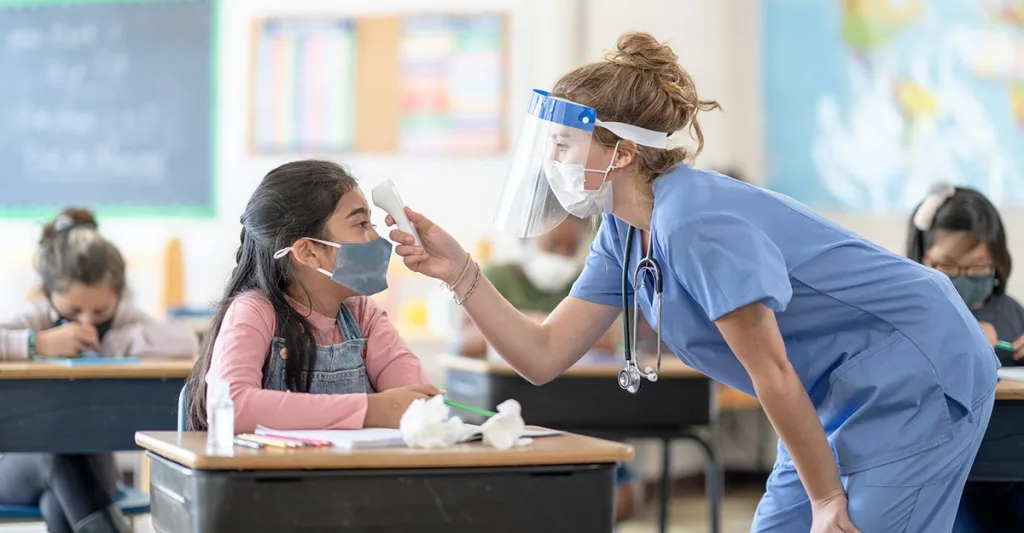Being a school nurse involves juggling a variety of roles. A school nurse conducts health screenings, manages student medications, provides care for injuries and illnesses, and participates in Individual Education Plan (IEP) meetings for students.
Due to the close contact in classrooms, common childhood illnesses can spread rapidly among school-aged children. It’s important for school nurses to recognize and manage the symptoms of various illnesses, including COVID-19, colds, flu, stomach flu, ear infections, strep throat, pink eye, head lice, and chickenpox.
Colds in the classroom
Nearly every child experiences the common cold at some point, presenting with symptoms such as a runny nose, cough, sore throat, and occasionally a mild fever. As a viral infection, it can spread quickly. To reduce transmission, school nurses should encourage frequent hand washing, proper use of tissues for sneezes and coughs, and correct disposal of tissues. These simple practices can significantly reduce the transmission of colds.
Dealing with flu and stomach flu
The flu, or influenza, is more serious than a cold. It comes with a high fever, chills, body aches, and fatigue. If a student shows these symptoms, it’s important to follow sick policies, which means notifying parents and making sure the child gets plenty of rest at home.
Stomach flu, or gastroenteritis, causes vomiting, diarrhea, and stomach cramps. This illness can spread quickly and is usually caused by a virus or bacteria. Nurses need to educate students and their parents on the importance of hydration, regular hand washing, and cleaning surfaces to avoid spreading the infection.
Managing ear infections and pink eye
Ear infections are quite common in children and can lead to ear pain, fever, and irritability. If a student exhibits these symptoms, a school nurse needs to inform their parents to ensure they receive appropriate medical attention. Additionally, monitoring these infections can help identify any emerging patterns.
Pink eye, or conjunctivitis, is another common health condition. A student may present with red, itchy eyes and sometimes a gooey discharge. Pink eye can be caused by viruses, bacteria, or allergies and school nurses should identify the condition quickly and keep affected students isolated to prevent spreading. Providing parents with information on treatment options and when to see a doctor is also important.
Handling head lice and chickenpox
Head lice are an inconvenience but not a health threat. Symptoms include an itchy scalp and visible lice or nits in the hair. A school nurse must address these cases with sensitivity and take measures to control the spread. It's also important to dispel the myth that head lice result from poor hygiene or unclean environments. Educating parents with accurate information about head lice, including treatment options, prevention strategies, and ways to manage the associated stigma, can effectively address these issues.
Chickenpox is less common now thanks to vaccines, but it can still occur in schools. Symptoms include an itchy rash with red spots and blisters. If a student has chickenpox, they should be kept away from others until they’re no longer contagious. It’s also a good idea to talk to families about the importance of vaccination and monitor for any complications.
Communicating with parents and keeping records
Keeping parents informed is key. A school nurse should regularly update parents on their child’s health and provide guidance on managing symptoms at home. Good communication helps ensure students get the consistent care they need.
Documenting student health is also important. Keeping detailed records of illnesses and treatments helps track trends and spot any recurring issues. Using an electronic health record (EHR) system can make this easier and keep everything organized and secure.
Managing the spread of COVID-19
Since early 2020, school nurses have also dealt with coronavirus (COVID-19) in schools.
On top of normal school nurse responsibilities, the pandemic added tasks like creating COVID-19 mitigation strategies, screening for symptoms, testing students and staff, and keeping up with changing guidelines and protocols.
Addressing vaccine hesitancy
Vaccine hesitancy isn’t new, but it’s become more common since the pandemic. School nurses can play an important role in promoting vaccine compliance by listening to parents, answering questions, and providing information on the risks and benefits of childhood vaccines.
The National Association of School Nurses offers a continuing education course for school nurses who want to learn effective strategies to combat vaccine myths and to engage in productive conversations with vaccine-hesitant parents.
Providing access to health resources
School nurses need to make sure that students and their families have access to essential health resources. This could involve providing a comprehensive list of local clinics and health services, including those that support uninsured individuals or families in need of financial assistance.
Managing common childhood illnesses is a big part of a school nurse’s job. By promoting good hygiene, following clear policies, handling symptoms effectively, and managing outbreaks, school nurses can help keep students healthy and in school. Good communication with parents and keeping accurate records are also crucial. With these practical tips, school nurses can navigate the challenges of childhood illnesses and support their students’ health.








